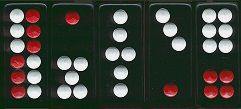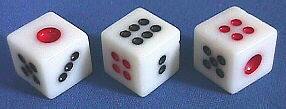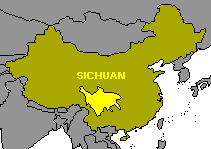
FIFTEEN POINT CARDS
The difficult Cantonese name of this 84-card deck is Sap Ng Wu Pai;
it features black and red dots, as in a Chinese domino set.
Despite these dominoes have pips from 1 to 6, forming 21 different combinations, while in the Western
ones the values start from 0 (blank), forming 28 of them, the total number of Chinese
tiles is 32: in fact 11 combinations are repeated twice (top left row in the following illustration).

the full set of combinations in Chinese dominoes (left) and Western dominoes (right)
In several games the single combinations (bottom left row) are said to be "military",
while the double ones are named "civilian", and many of them have a nickname,
vaguely inspired by the shape of the pip arrangement (6-6 = heaven,
5-6 = hatchet, 1-6 = long leg seven, etc.).

sample of domino cards from an edition by Guan Huat (Hong Kong) |
Another difference in Chinese domino sets is the use of red pips too: 1s, 4s and one row
of the double 6s are red, a feature shared by Oriental dice
(the latter have only the 1 and 4 in red).

Chinese domino tiles
|
The Sap Ng Wu Pai deck has many more cards than a tile set, because all the 21
basic combinations are quadruple, for a total of 84 cards.
As in other Chinese patterns, the value (i.e. the combination of pips) is repeated on
both ends of the card. This would not be possible with Western dominoes, since in most games
tiles or cards have to be matched with other pieces by either one or the other end; but
this is not the scheme of Chinese domino games.

Oriental dice: note the use of red pips
|

edition by "Double Happiness" Brand
(China) |
A typical feature in Chinese domino cards is the tiny decoration
that all subjects have in the center, to divide the two halves: each arrangement of
pips shows a different illustration.

Several games are played with these cards, among which
Pai Gow is the most famous one (see John McLeod's
National And Regional Card Games page for more details).
Lastly, a linguistic curiosity.
The name of this pattern, as it is spelled nowadays, literally means "fifteen lake cards",
since the third character from the left

(
wu,
or
hu in Mandarin) is the actual one for "lake". This paradox might be explained by the fact that who played gambling games
in China were almost exclusively the low social classes, among which the cultural
knowledge was very poor. Sometime in the past, the character that originally
formed the name "fifteen point cards" might have likely been replaced with the present one
due to a wrong transcription, as

is very similar in
shape and sound to

(
wu,
or
hu in Mandarin, whose different meanings are "paste", "make a living", but often used as "point, scoring" in
gambling games). However, the present spelling, albeit incorrect, has traditionally remained
unchanged.
(thanks to C.P.Lai for this contribution)
The rules for the game of
Tien Gow and the full set of 32 Chinese domino tiles can be found
in ChungPang Lai's
A Chinese Domino Game: Tien Gow (天九 Heaven Nine).

SICHUAN CARDS
 |
This is a different variety of domino deck, whose name Chuan Pai
literally means "river cards", though referring to the province of SiChuan (i.e. "Four Rivers"),
located in the south-west.
The size of these cards is about twice the length and width of the aforesaid "15 point cards".
Most editions have decorative pictures in the central part, and also these are
quite large, compared to the tiny figurines that appear in the previous pattern. |
Also in the SiChuan pattern the two ends of
each card feature dots variously combined, similar to those found in the previous pattern,
though in this variety they are arranged side by side, e.g. a 4-4 card is
 , while in the "fifteen point cards" they would look like
this  , with one 4 above the other.
In Chinese domino the different pip combinations are 21: according to how many
times each card is duplicated, Chuan Pai decks may contain a variable number of
cards. |

samples of SiChuan cards featuring personages
from "The Water Margin"; all the cards shown have the flourish |
In most modern editions, for each subject (i.e. 1-1, 1-2, 1-3 etc.)
there are five identical cards, for a total of 105, but there are fewer decks with four
identical ones per subject (84 cards).

two 6-6 cards, one with
the flourish and one without |
Often, for each subject, i.e. each series of five identical
cards, one of them features an arabesque or flourish between the dots and the central picture,
while the other four do not have it.
Most decks also have two special subjects: their characters mean "listen - use"
and "god of wealth", and also these ones are duplicated as many
times as the pip cards are (usually five), or may be present as single cards.
Their pictures may be different from the ones of the pip cards, but they are
usually inspired by the same theme. With these ones, the total number of
cards in a deck rises to 115 (including the five + five specials), or
107 (with a single couple of "listen - use" and "god of wealth"). |

the "god of wealth" (left)
and the "listen - use" |

samples from a Chuan Pai deck that features
personages of "The Dream Of The Red Mansion" |
Not all Chuan Pai decks feature personages
from "The Water Margin", although the latter is indeed the most common theme also
for this variety of cards. Other sources of inspiration are different
literary works, such as the one on the left, whose theme is "The
Dream Of The Red Mansion", a popular novel, or famous legends
such as that of the Yang Generals, a sample of which is shown below.
Usually in this kind of deck, by each picture the name of the relevant
personage is also specified. |